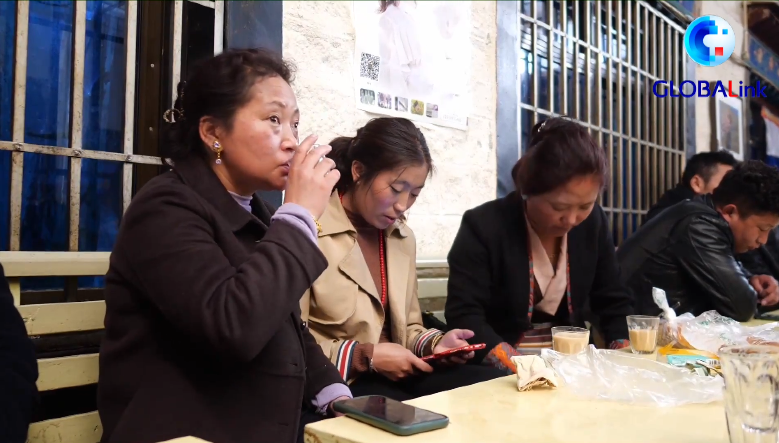Nov.25,2020 -- Over 10 million poor people in China have become migrant workers who work outside their hometowns over the past 5 years, with the country witnessing significant progress in using employment as a poverty-alleviation method, according to a press conference held by the State Council Information Office on Nov. 19. Villagers process saffron crocus stigmas to make them into herbal medicine in Zhuba Village of Cengong County, Qiandongnan Miao and Dong Autonomous Prefecture, southwest China''s Guizhou Province, Oct. 29, 2020. More than 200 local farmers now work for the seasonal job at the saffron crocus planting base piloted in Zhuba Village as a poverty relief project. (Photo/Xinhua)
As of the end of October, the number of migrant workers from impoverished households who work outside their hometowns in China reached 29.73 million, a 8.9 percent incease from 2019, disclosed Li Zhong, deputy head of China’s Ministry of Human Resources and Social Security (MHRS).
Li briefed reporters on China’s achievements in alleviating poverty through employment at the press conference, and summarized the measures being taken to boost employment for the impoverished workforce.
The country has rolled out a package of policies and measures to reduce poverty through employment, including providing companies that hire impoverished people with a fixed amount of tax deductions or exemptions, subsidies for recruiting poor people, social insurance subsidies, and guaranteed loans and interest subsidies for startup firms that recruit poor people, Li said.
China has also provided postal allowances and purchased accidental injury commercial insurance for poor people on public-service jobs, and offered vocational training subsidies and living subsidies for poor people who take part in training programs for employment, according to Li.
The country has tried its best to help poor people who want to become migrant workers secure employment outside their hometowns, and at the same time spared no effort to create jobs for people who want to work near their homes, Li noted.
The country has accumulatively established 32,688 poverty alleviation workshops, which have recruited 437,000 people from poor households, Li said, adding that more than 410,000 “shaking off poverty and becoming rich” role models have been cultivated in China, helping increase incomes for 4.06 million poor people across the country.
China has also arranged public-service jobs in villages for more than 4.96 million poor people, Li disclosed.
The country has provided targeted employment services to match people to jobs, accumulatively trained poor people in vocational skills 8.38 million times, enrolled 340,000 students from registered poor households at technical colleges and universities, and safeguarded the legitimate rights and interests of poor people during work, Li stressed.
More financial support, favorable policies, and services have been channeled to areas of extreme poverty such as the “three regions and three prefectures”, (“three regions” refers to Tibet, four prefectures of southern Xinjiang—Hotan, Aksu, Kashi, and the Kirgiz Autonomous Prefecture of Kizilsu, and the areas of Sichuan, Yunnan, Gansu, and Qinghai provinces with large Tibetan populations; the “three prefectures” are Liangshan in Sichuan, Nujiang in Yunnan, and Linxia in Gansu.)”, 52 counties that have not yet shaken off poverty, poverty-relief relocation sites, and central China’s Hubei province, which was hit particularly hard by the COVID-19 pandemic, Li explained.
Over the past 5 years, poor families in China have seen their income from wages and salaries continuously rising year after year. At present, two thirds of the country’s poor households have migrant workers, and about two thirds of these households’ incomes are earned by family members working outside their hometowns.
Trans-regional and trans-provincial labor service cooperation has played an important role in the country’s efforts to promote employment for poor households.
In labor service cooperation among different provinces, provinces in the eastern areas of the country provide information on demand for workers and relevant requirements, and provinces in central and western regions of China organize targeted training according to the demand and then export labor.
In 2020, 4 million more poor migrant workers were employed in provinces outside their home provinces than in the year 2016. And according to incomplete statistics, trans-provincial poor migrant workers earn the highest income among all poor migrant workers, said Ou Qingping, deputy head of the State Council Leading Group Office of Poverty Alleviation and Development.
Ningbo, east China’s Zhejiang province, is currently home to 3.85 million migrant workers, accounting for 57 percent of the city’s total work force, said Chen Zhongchao, executive vice mayor of Ningbo.
Of all the migrant workers in Ningbo, 315,000 are from registered poor households in the central and western regions of China, Chen said.
The city has not only helped bring these migrant workers from their hometowns to suitable posts, but also ensured that they can enjoy stable employment in the city through measures including offering subsidies to enterprises for stabilizing employment, Chen disclosed.
Under the guidance of the MHRS, 6 provincial-level regions in east China, including Shanghai municipality and Guangdong province, have made efforts to help Hubei province promote employment for poor people.
So far, 1.99 million poor migrant workers from Hubei province have enjoyed stable employment in these regions, with the figure representing 75.6 percent of the total number of poor migrant workers in the province.
|
- Home
- News Tibet |Exclusive |China |World |Related News |Latest
- Documents White Papers |Others
- Photo Politics |Economy & Society |Culture & Religion |Human & Nature |Beautiful Tibet |Other Tibetan-Inhabited Area |Exchanges |Related
- Video News |Documentary |Micro-Video |Entertainment
- Art
- Tourism
- In Focus
- About Tibet






